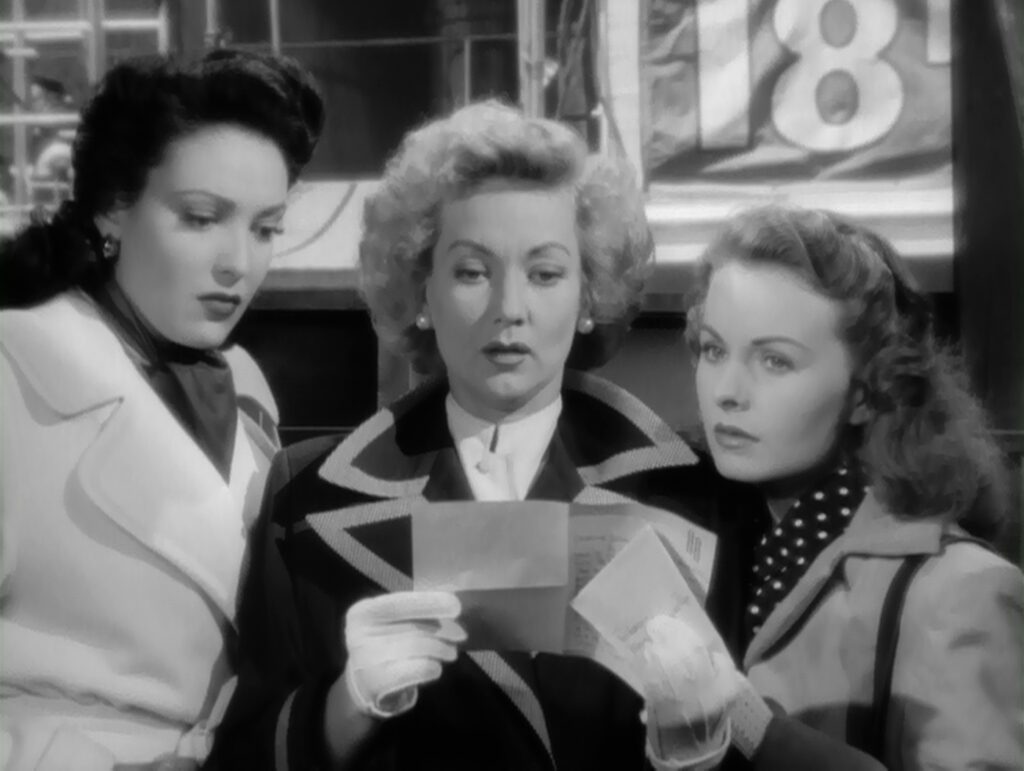
A Letter to Three Wives
1949, directed by Joseph Mankiewicz
A Letter to Three Wives is predicated on a trick question: Whose husband did Addie Ross run off with? It seems simple enough. The three wives get the jeering letter from Ms. Ross just as they’re about to board an afternoon river cruise, leaving them all to wonder for several hours who the unlucky wife might be. The mystery is a trick question twice over, because it seems to present two alternatives. We may ask whose husband Addie Ross was most attracted to, or we could ask which husband would be most likely to cheat. As it happens, neither of these is the right question. None of the wives realizes that, and the audience is unlikely to guess it either.
The casting and characterization of the three husbands plays right into this red herring. The questions are so hard to answer because the possibilities are so carefully balanced. Brad and George are both good looking, Brad and Porter are rich, and George and Porter have personalities. Given what we know about Addie, she might be attracted to any one of them. Likewise, each husband has a plausible reason to run after Addie Ross: Brad likes women for their beauty, George admires taste, and Porter is drawn to class. Addie, we are told, has all three qualities in abundance. Still, none of these factors proves decisive in the end. The real question is in plain sight all along, at least if we watch closely.
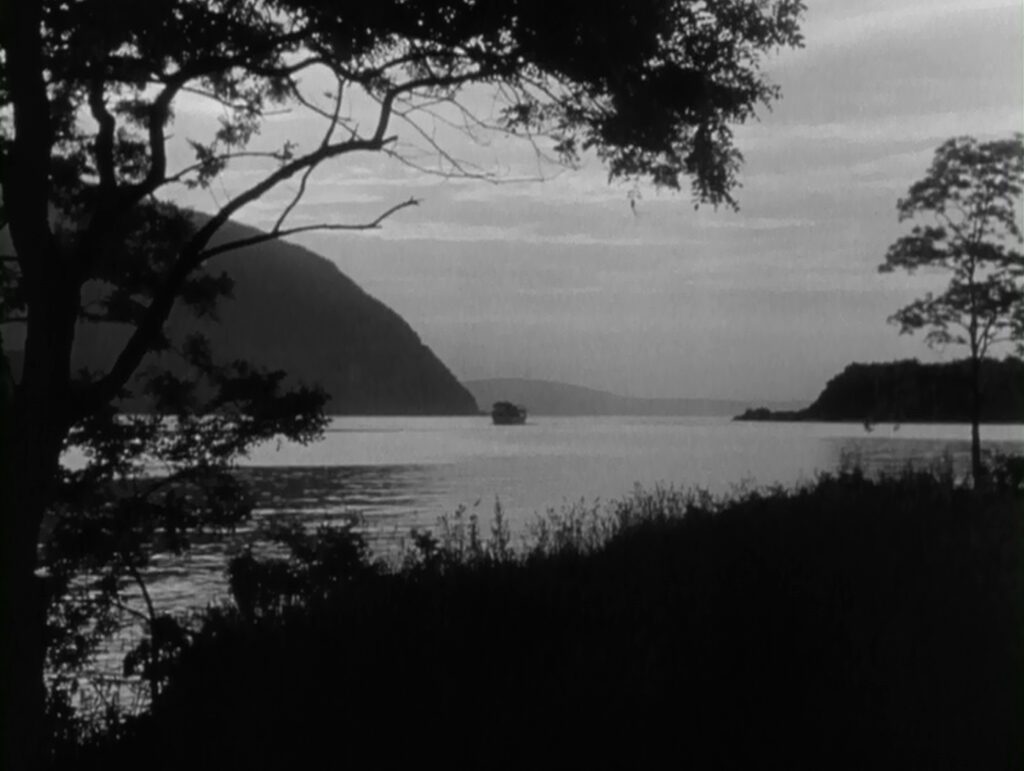
A Letter to Three Wives is a broad portrait of the United States about four years after World War II. Two decades after the stock market crash of 1929, normal life and prosperity are finally returning, although the economic fruits are spread unevenly. As the opening shots indicate so pointedly, the setting is a generic slice of America that would be familiar to most of the population. It includes a Main Street, a middle class neighborhood, the country club set, and the “wrong side of the tracks”. The characters live in a medium sized town within commuting distance of a large city but also close to nature and rural America. It’s filmed along the Hudson River, and the story would fit upstate New York, but Mrs. Manleigh’s allusion to “the three states adjoining this one” rules out that possibility. Rather than portraying any specific location, the movie purposefully creates a microcosm of the United States.
As if to mirror the nation’s democratic character, no single character dominates the story. The three-part structure gives equal weight to the three couples, and the long flashbacks hold the plot in abeyance so the movie can focus on characterization. Addie Ross is the disruptive force driving the plot, and she might have dominated if she had had any screen time, but we never see more than the edge of her body once or twice. In any case we can sense that she’s antithetical to the democratic spirit of the three couples, who seem to treat each other equally despite their varied and unequal backgrounds.
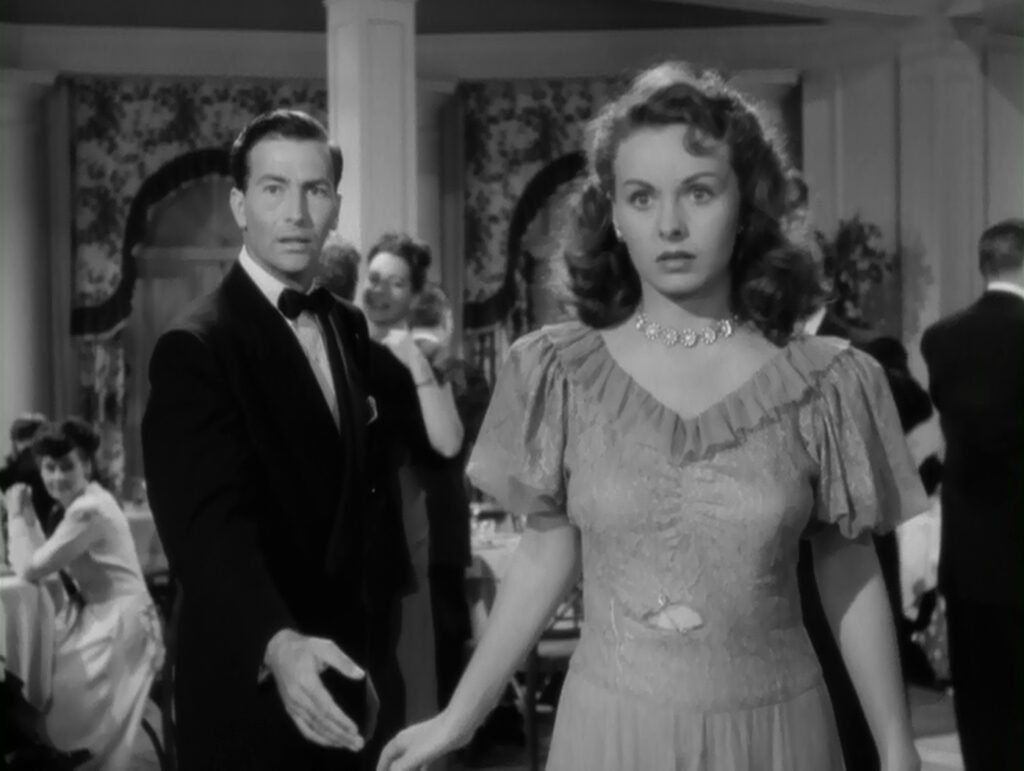
The movie pays careful attention to each character’s economic status. Each one, including supporting characters like Mrs. Finney, the Manleighs, and Sadie, is drawn so precisely that anyone could make a good guess as to how the character would vote in an election, even without a single reference to politics in the script. Debbie (Jeanne Crain) is an insecure farm girl anxious to fit into higher society. Her husband Brad (Jeffrey Lynn) is nonchalant and insensitive, privileged since birth. Rita (Ann Sothern) is an ambitious, hard working career woman, eager to please her boss even if it compromises her values a bit. George (Kirk Douglas) is a highly cultured English teacher, insecure about his financial worth, but fortified by a philosophical attitude toward wealth. Lora Mae (Linda Darnell) is a practical young woman from a poor background who knows what she wants and how to get it. Porter (Paul Douglas) is the wealthiest of the bunch, a self-made businessman who admires class but has none of his own. Each of the couples is in love, but economic disparities impede the intimacy of all three relationships. Meanwhile Addie Ross sits above everyone, her assumed air of superiority evident in her sarcastic voice and even in her calligraphy.
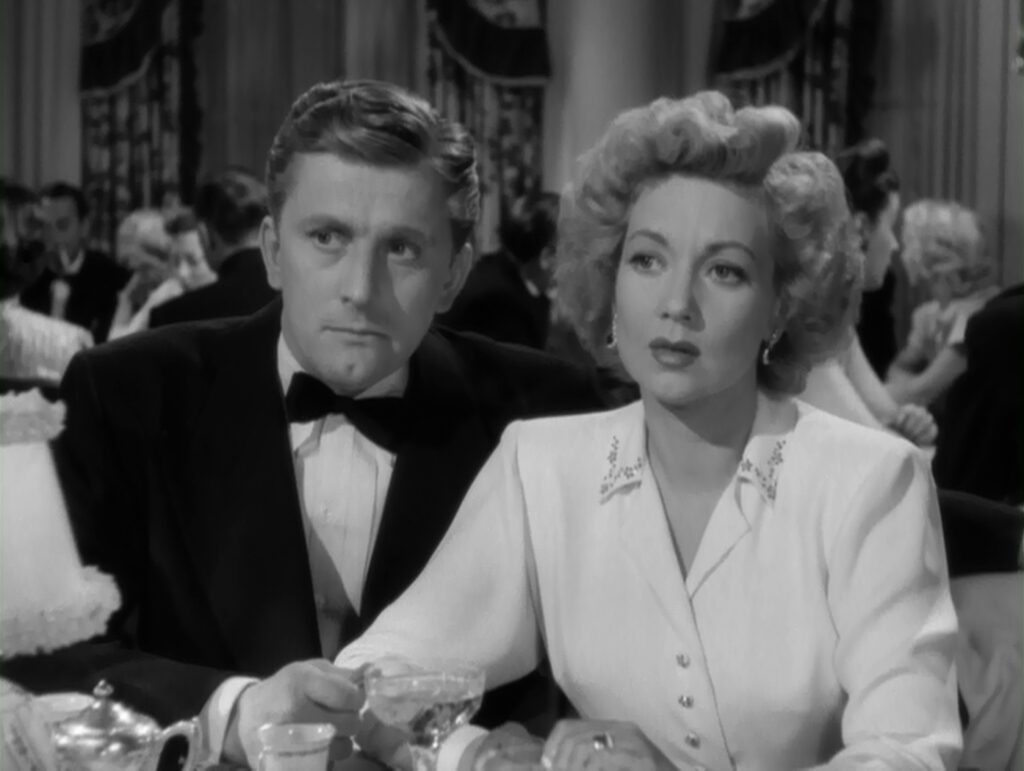
The egalitarian ideal is so pervasive that it extends even into the marital relationships, making the movie rather progressive for its time. The slightest imbalance in each marriage eventually gets righted. Each husband mistreats his wife exactly once, and in each case the wife does the same thing back to him. Porter tells Lora Mae to shut up, but at the end she shuts him up. George pushes Rita into an armchair, and she reciprocates later. Brad disgraces Debbie at the country club when her dress falls apart, but in the final scene she disgraces him in absentia in the same place when she tells their friends he’s run off with Addie Ross. In fact he is innocent of this sin, just as the dress was not her fault.
Given how precise the movie is about economic class, it’s expected that the characters too would be mindful of their own statuses vis-à-vis their friends. When Debbie blows up at Rita in the first flashback, it’s not only because she’s drunk and self-conscious but also because she envies Rita’s confidence. Rita envies Addie Ross for her refined taste and for having the grace to remember George’s birthday. Lora Mae’s sister Babe envies Lora Mae for her high aspirations and for the attention she gets, and Lora Mae envies Addie Ross for her picture in the silver frame. None of these relatively mild forms of envy however compares to Addie’s vicious envy of the three wives, especially of Lora Mae. Addie Ross is smart enough to recognize that Lora Mae is no simple gold digger – she’s an extraordinarily capable woman, and it bothers Addie that such a person rose so fast from her humble and, in her mind, contemptible station.
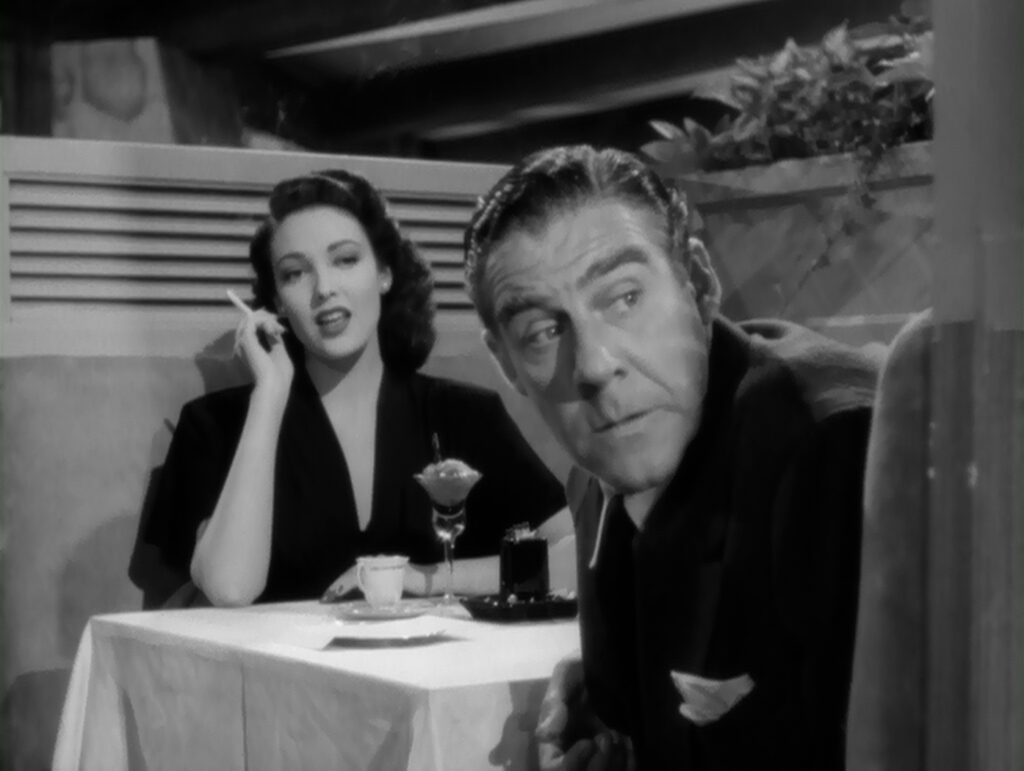
The real question at the heart of A Letter to Three Wives, then, has nothing to do with which husband Addie Ross ran off with. It’s which of the three wives Addie hates the most. The last shot confirms that her malice is the key. The invisible spirit of Addie Ross tips over a champagne glass and breaks it on the table just when her mischief has been thwarted.
Addie Ross’s motivation might seem like a minor detail, because her reason doesn’t change the story, but it makes all the difference. The movie’s insight is contrary to common sense. Most people imagine that envy is typically directed upward, from those who want something to those who have it, and they also assume that envy is more destructive when focused upward. A Letter to Three Wives tells us – and a brief reflection on the ways of the world bears this out – that envy tends to be a greater force when it’s directed downward. People like Addie Ross are not uncommon, and they play a decisive part in politics and economics. Even if the wealthy get no material benefit from keeping the poor in their place, doing so maintains their superiority, and many of them guard their status jealously. The poor and middle class have by and large made their peace with the more fortunate, and the notion of seething class resentment is inflated almost to the level of a myth. People are far more likely to envy someone close who suddenly rises higher or reveals a hidden talent, than someone who has held a high status for a long time.
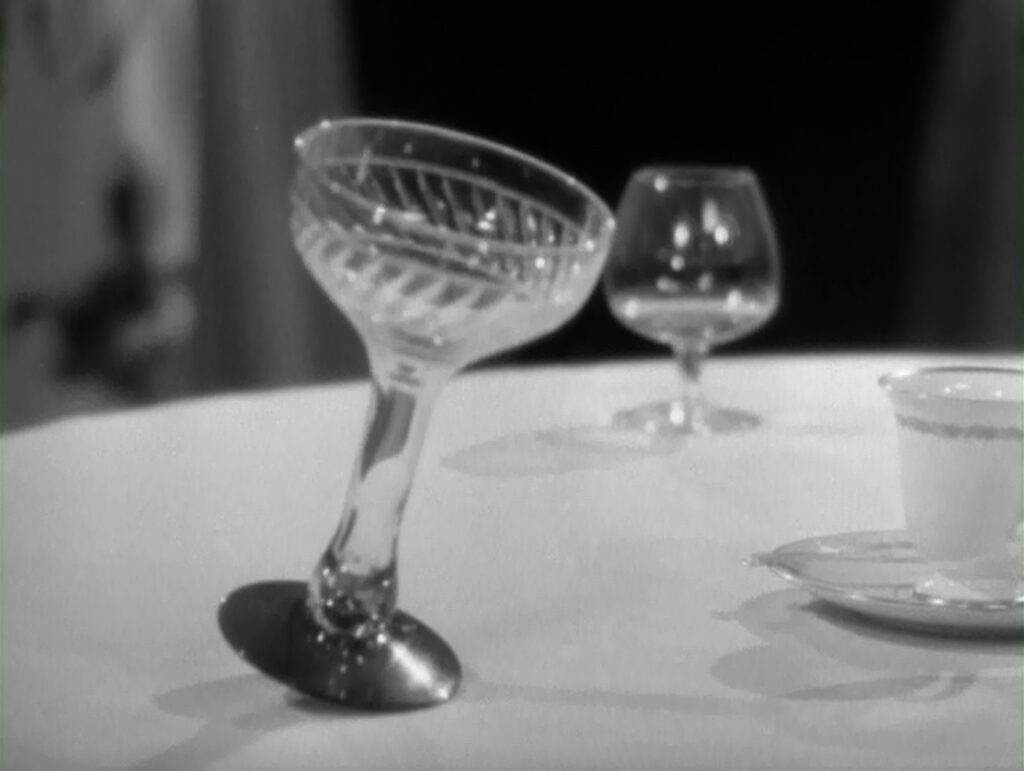
Joseph Mankiewicz’s films are distinguished by their insights into the surprising forces that drive people. The Ghost and Mrs. Muir looks at how romantic notions shape the course of Mrs. Muir’s life. All About Eve pits Margo’s natural talent against Eve’s ambition, which is driven by a belief that theater is more real than life. 5 Fingers is about how a single image of great dignity supplies the hidden force guiding a spy who almost changes the course of history. A Letter to Three Wives is remarkably transparent about the motivations driving its six main characters. Their personalities and desires are open not only to the audience but to each other, so that however great their differences may be, they all negotiate them easily. It’s the unseen character, Addie Ross, whose motives are hidden, so that even though she’s at the top of the social scale, she’s the one who won’t fit in. What makes the final shot so powerful is not only that her scheme has failed, but that she is symbolically left all alone, an outcast at a vacant table.
CONNECTIONS:
Rebecca – Reversed assumptions about inequality, especially the ways people look at the upper class
Ladies in Retirement – Group of characters differentiated systematically along a matrix of qualities
Born Yesterday – Portrait of the postwar United States and its class divisions
Stalker – Passing train shaking a house; glass tipped over supernaturally at the end